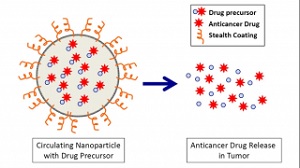 |
| Nanoparticle used for neuroblastoma in children--Courtesy of CHOP |
At the Children's Hospital of Philadelphia (CHOP), researchers are looking toward biodegradable nanoparticles capable of delivering cancer drugs to neuroblastoma without harming surrounding tissue.
The nanoparticles take advantage of what scientists call the "EPR effect"--enhanced permeability and retention--to target the drugs. This weakness in tumors causes blood vessels to form incorrectly and become more leaky and disorganized, the researchers said. Thus, they designed the nanoparticles to bypass what can be identified as healthy tissue by its organized blood vessel structure and instead take aim at the tangled mess at the tumor site.
The scientists delivered the nanoparticle-encapsulated drug, called SN38, to mice. They found that the mice with the new drug had 100 times the amounts of the active treatment delivered to the tumor than mice with the traditional cancer drug irinotecan. The treatment persisted 72 hours with no evidence of toxicity, according to a hospital report.
"We carefully adjust the size of the nanoparticles to find a 'sweet spot': small enough to penetrate a tumor, and large enough to carry a therapeutic payload," researcher Michael Chorny said in a statement. "We can also adjust their composition to keep the active molecule entrapped in a polymer until nanoparticles reach the targeted tumor, and customize the timing of the polymer's breakdown to allow controlled release of SN38 over a time scale that provides the best therapeutic effects."
The rate of improvement in treatments for childhood cancers has lagged behind that in adult cancers, with neuroblastoma in particular, according to the hospital.
"In pediatric oncology, we have largely relied on drugs developed 30 to 40 years ago," CHOP researcher Garrett Brodeur said. "While these have greatly improved overall cure rates over that period from 20 percent to 80 percent, we still need better drugs and more targeted approaches for the most stubborn childhood cancers, including high-risk forms of neuroblastoma."
- here's the CHOP report